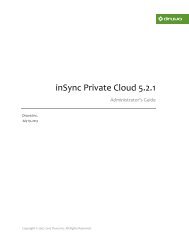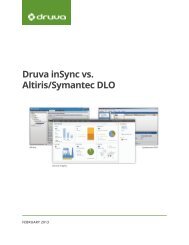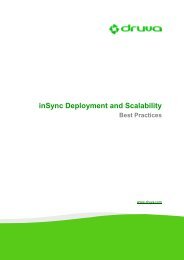inSync Private Cloud 5.2 - inSync Help - Druva
inSync Private Cloud 5.2 - inSync Help - Druva
inSync Private Cloud 5.2 - inSync Help - Druva
You also want an ePaper? Increase the reach of your titles
YUMPU automatically turns print PDFs into web optimized ePapers that Google loves.
<strong>inSync</strong> <strong>5.2</strong> <strong>Private</strong> <strong>Cloud</strong> – Administrator’s Guide<br />
About Storages<br />
In <strong>inSync</strong>, storage is a location where data backed up and shared from the user's devices are stored.<br />
An <strong>inSync</strong> Server can have multiple storages associated with it.<br />
Each storage in <strong>inSync</strong> requires three folders - a data folder, a database folder, and a database logs<br />
folder. The data folder contains the actual data backed up from the user's devices. The database<br />
folder contains an <strong>inSync</strong> database that stores the metadata of the backed up data. The information<br />
stored in the database is essential for <strong>inSync</strong> to identify the data for each user. The database log folder<br />
contains the log files related to all transactions that happens in the <strong>inSync</strong> database.<br />
As long as you store less than 1 TB of data in a storage, you can use the same folder as the data folder,<br />
database folder, and the database log folder. However, if you are planning to store more than 1 TB of<br />
data in a storage, use separate folders for each. You can have the data folder on any storage media -<br />
local hard drive, NAS, SAN. However, the database folder and the database log folders must always be<br />
on the local hard drive. You must not use a networked or shared drive for your database folder and<br />
database log folder.<br />
Few frequently used terms related to storages are as follows:<br />
<br />
<br />
<br />
<br />
<br />
<br />
Storage disk space<br />
Storage health<br />
User quota<br />
Storage compaction<br />
Data deduplication<br />
Primary and secondary storages<br />
Storage Disk Space<br />
The storage disk space is the maximum amount of data that a storage can contain. The storage disk<br />
space is defined when it is created. However, it does not mean that space equivalent to the defined<br />
disk space is reserved on the media where the storage is created. The actual space occupied by a<br />
storage increases with the increase in usage.<br />
63









